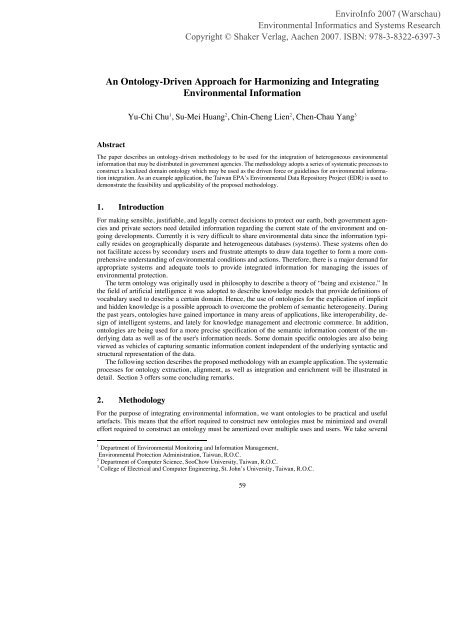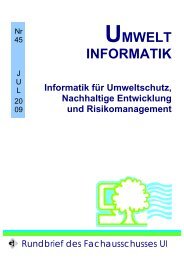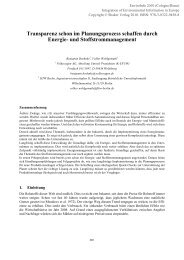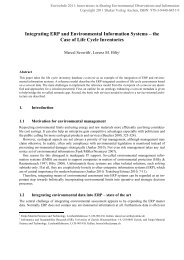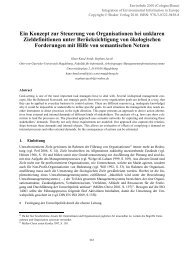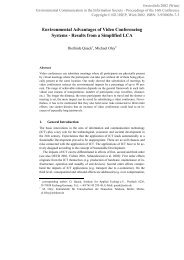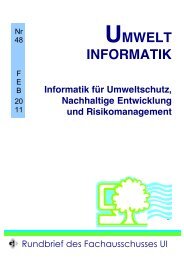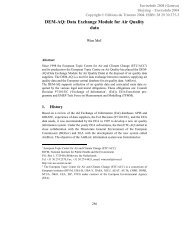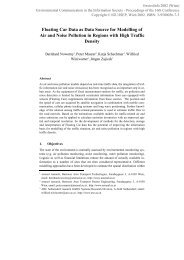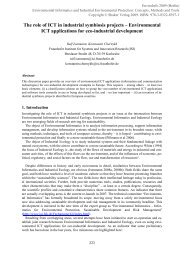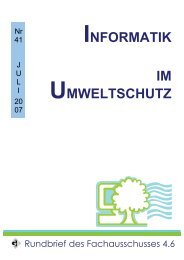EnviroInfo 2007: An Ontology-Driven Approach for Harmonizing and ...
EnviroInfo 2007: An Ontology-Driven Approach for Harmonizing and ...
EnviroInfo 2007: An Ontology-Driven Approach for Harmonizing and ...
You also want an ePaper? Increase the reach of your titles
YUMPU automatically turns print PDFs into web optimized ePapers that Google loves.
<strong>EnviroInfo</strong> <strong>2007</strong> (Warschau)<br />
Environmental In<strong>for</strong>matics <strong>and</strong> Systems Research<br />
Copyright © Shaker Verlag, Aachen <strong>2007</strong>. ISBN: 978-3-8322-6397-3<br />
<strong>An</strong> <strong>Ontology</strong>-<strong>Driven</strong> <strong>Approach</strong> <strong>for</strong> <strong>Harmonizing</strong> <strong>and</strong> Integrating<br />
Environmental In<strong>for</strong>mation<br />
Yu-Chi Chu 1 , Su-Mei Huang 2 , Chin-Cheng Lien 2 , Chen-Chau Yang 3<br />
Abstract<br />
The paper describes an ontology-driven methodology to be used <strong>for</strong> the integration of heterogeneous environmental<br />
in<strong>for</strong>mation that may be distributed in government agencies. The methodology adopts a series of systematic processes to<br />
construct a localized domain ontology which may be used as the driven <strong>for</strong>ce or guidelines <strong>for</strong> environmental in<strong>for</strong>mation<br />
integration. As an example application, the Taiwan EPA’s Environmental Data Repository Project (EDR) is used to<br />
demonstrate the feasibility <strong>and</strong> applicability of the proposed methodology.<br />
1. Introduction<br />
For making sensible, justifiable, <strong>and</strong> legally correct decisions to protect our earth, both government agencies<br />
<strong>and</strong> private sectors need detailed in<strong>for</strong>mation regarding the current state of the environment <strong>and</strong> ongoing<br />
developments. Currently it is very difficult to share environmental data since the in<strong>for</strong>mation typically<br />
resides on geographically disparate <strong>and</strong> heterogeneous databases (systems). These systems often do<br />
not facilitate access by secondary users <strong>and</strong> frustrate attempts to draw data together to <strong>for</strong>m a more comprehensive<br />
underst<strong>and</strong>ing of environmental conditions <strong>and</strong> actions. There<strong>for</strong>e, there is a major dem<strong>and</strong> <strong>for</strong><br />
appropriate systems <strong>and</strong> adequate tools to provide integrated in<strong>for</strong>mation <strong>for</strong> managing the issues of<br />
environmental protection.<br />
The term ontology was originally used in philosophy to describe a theory of “being <strong>and</strong> existence.” In<br />
the field of artificial intelligence it was adopted to describe knowledge models that provide definitions of<br />
vocabulary used to describe a certain domain. Hence, the use of ontologies <strong>for</strong> the explication of implicit<br />
<strong>and</strong> hidden knowledge is a possible approach to overcome the problem of semantic heterogeneity. During<br />
the past years, ontologies have gained importance in many areas of applications, like interoperability, design<br />
of intelligent systems, <strong>and</strong> lately <strong>for</strong> knowledge management <strong>and</strong> electronic commerce. In addition,<br />
ontologies are being used <strong>for</strong> a more precise specification of the semantic in<strong>for</strong>mation content of the underlying<br />
data as well as of the user's in<strong>for</strong>mation needs. Some domain specific ontologies are also being<br />
viewed as vehicles of capturing semantic in<strong>for</strong>mation content independent of the underlying syntactic <strong>and</strong><br />
structural representation of the data.<br />
The following section describes the proposed methodology with an example application. The systematic<br />
processes <strong>for</strong> ontology extraction, alignment, as well as integration <strong>and</strong> enrichment will be illustrated in<br />
detail. Section 3 offers some concluding remarks.<br />
2. Methodology<br />
For the purpose of integrating environmental in<strong>for</strong>mation, we want ontologies to be practical <strong>and</strong> useful<br />
artefacts. This means that the ef<strong>for</strong>t required to construct new ontologies must be minimized <strong>and</strong> overall<br />
ef<strong>for</strong>t required to construct an ontology must be amortized over multiple uses <strong>and</strong> users. We take several<br />
1 Department of Environmental Monitoring <strong>and</strong> In<strong>for</strong>mation Management,<br />
Environmental Protection Administration, Taiwan, R.O.C.<br />
2 Department of Computer Science, SooChow University, Taiwan, R.O.C.<br />
3 College of Electrical <strong>and</strong> Computer Engineering, St. John’s University, Taiwan, R.O.C.<br />
59
steps towards attaining that goal. First, we provide an environment that assists users to build prototype<br />
ontologies by extracting knowledge from the existing in<strong>for</strong>mation sources such as database schemas or<br />
DTD <strong>for</strong> XML documents. Secondly, the terms of concepts in the built prototype ontologies will align with<br />
existing common ontologies <strong>and</strong> some of the domain specific thesauri such as GEMET. The alignment may<br />
provide a semantic consistency among different ontologies. For example, the names of concepts facility-names,<br />
plant-names, site-names, <strong>and</strong> contaminant-sites will be aligned to a term in GEMET called “site.”<br />
After this process, the ontologies will be called aligned ontologies. Thirdly, the aligned ontologies will be<br />
merged <strong>and</strong> combined to <strong>for</strong>m an integrated ontology.<br />
2.1. Systematic processes<br />
The core component of our approach is the integrated ontology, which is dedicated to the domain of<br />
environmental protection. Figure 2.1 depicts the process of the proposed method. We explain the main<br />
steps of the method we propose <strong>for</strong> building an integrated ontology from existing knowledge sources such<br />
as the environmental databases owned by local governments <strong>and</strong> EPA at the central government level.<br />
Environmental<br />
data from local<br />
governments<br />
EPA owns<br />
environmental<br />
related data<br />
RDB Data<br />
<strong>and</strong> Schema<br />
XML/HTML<br />
Documents<br />
with DTD/<br />
Schema<br />
Ontologies<br />
Extraction <strong>and</strong><br />
Acquisition<br />
Extraction<br />
Models <strong>for</strong><br />
RDB<br />
Extraction<br />
Models <strong>for</strong><br />
XML <strong>and</strong><br />
HTML<br />
Coresponding Prototype<br />
Ontologies<br />
<br />
<br />
OntoBuilder<br />
Exixting Ontologies<br />
(top-level <strong>and</strong><br />
domain-specific)<br />
Metadata <strong>and</strong><br />
Dictionaries<br />
Thesauri (GEMET)<br />
Ontologies<br />
Importation <strong>and</strong><br />
Indigenezation<br />
<br />
Ontologies<br />
Alignment <strong>and</strong><br />
Integration<br />
Ontologies<br />
Enrichment<br />
Integrated<br />
Ontologies<br />
Figure 2.1: The process of the integration of environmental domain ontologies<br />
60<br />
Copyright © Shaker Verlag, Aachen <strong>2007</strong>. ISBN: 978-3-8322-6397-3
1. Selection of underlying in<strong>for</strong>mation sources, st<strong>and</strong>ards, laws <strong>and</strong> regulations, classifications, etc.<br />
In this step, we select the sources of in<strong>for</strong>mation that we consider relevant to the target domain, <strong>for</strong><br />
example, environmental protection, or e-Business <strong>for</strong> a certain industry. They usually provide<br />
taxonomy of concepts <strong>and</strong> terminologies used in the domain.<br />
2. <strong>Ontology</strong> extraction <strong>and</strong> acquisition. This step per<strong>for</strong>ms the process of knowledge acquisition from<br />
the sources of in<strong>for</strong>mation previously selected <strong>and</strong> adapts them to <strong>for</strong>m a prototype ontology <strong>for</strong><br />
each knowledge source. This activity can be per<strong>for</strong>med using tools such as Ontolingula <strong>and</strong> WebODE.<br />
We have been implementing a simple tool set <strong>for</strong> this activity called OntoBuilder, which<br />
focuses on the relational database schema <strong>and</strong> XML documents. In addition, we also employ the<br />
procedure of “protocol analysis” with domain experts. This procedure consists of asking users to<br />
describe various types of domain applications, the data used in such applications, <strong>and</strong> the terms used<br />
in their field. Several such sessions of protocol analysis may result in a st<strong>and</strong>ard set of terms <strong>and</strong><br />
inter-relationships among these terms.<br />
3. <strong>Ontology</strong> importation <strong>and</strong> indigenization. In this step, we import ontologies that are existing ontologies<br />
in target domains but might usually be used in other countries or areas. For example, in the<br />
domain of environmental protection, the OECD 4 countries commonly adopt a classification, which<br />
can be seen as an ontology <strong>for</strong> identification of environmental industry. Most countries in European<br />
area use GEMET, which is a thesaurus <strong>for</strong> unifying the terminology in environmental use. Those<br />
ontologies are helpful to construct new ontologies. However, when importing those ontologies, we<br />
need to tailor them to fit the feature in the area or country where ontologies will be applied. For<br />
example, if we want to adopt the OECD classification <strong>for</strong> use in Taiwan, we have to delete some of<br />
the items in the classification such as <strong>for</strong>est management, re<strong>for</strong>estation because they are not under<br />
the jurisdiction of the Environmental Protection Administration in Taiwan.<br />
4. <strong>Ontology</strong> alignment <strong>and</strong> integration. This activity consists of two processes. First, align the prototype<br />
ontologies with imported ontologies or upper level ontologies. This process may include adjusting<br />
the name or terminology in the prototype ontologies <strong>and</strong> making them consistent with each<br />
other. Secondly, we combine <strong>and</strong> merge the prototype ontologies to <strong>for</strong>m an integrated ontology.<br />
5. <strong>Ontology</strong> enrichment. Traditionally, most of the ontologies merely represent taxonomy of concepts,<br />
where others may just include some attributes <strong>for</strong> them. In this activity, we will enrich the integrated<br />
ontologies with extra in<strong>for</strong>mation where available.<br />
2.2. Example application<br />
We use the Environmental Data Repository Project (EDR) 5 of the Taiwan Environmental Protection Administration<br />
(TEPA) as a pragmatic example to illustrate the process of implementation. EDR is an integrated<br />
data warehouse system that provides a single point of access to data extracted from several major<br />
TEPA databases, including the Air Pollution Control System, the Water Permit Database, the Hazardous<br />
Waste Control System, <strong>and</strong> the Toxic Release Database. We construct the integrated ontology by extracting<br />
the domain knowledge from some of the in<strong>for</strong>mation sources <strong>and</strong> aligning the concepts in the ontology with<br />
the laws <strong>and</strong> regulations of Taiwan EPA. The ontology becomes a major component to drive the integration<br />
process of the EDR project. Based on the implementation of a prototype system of EDR project, we may<br />
justify the applicability of our approach.<br />
4 Organization <strong>for</strong> Economic Co-operation <strong>and</strong> Development<br />
5 http://edb.epa.gov.tw<br />
61<br />
Copyright © Shaker Verlag, Aachen <strong>2007</strong>. ISBN: 978-3-8322-6397-3
!"<br />
!"<br />
!"<br />
GEMET<br />
Alignment<br />
Integration<br />
Enrichment<br />
subject-oriented<br />
in<strong>for</strong>mation retrieval<br />
<br />
!"<br />
environmental<br />
domain ontology<br />
(a) <strong>An</strong> example of term integration<br />
Figure 2.2: Example application<br />
(b) EDR homepage<br />
As shown in Figure 2.2(a), each in<strong>for</strong>mation source might maintain the data regarding the potential pollution<br />
sites. However, they do not use the same database schema <strong>and</strong> cause a conflict between the terms that is<br />
used to identify the sites. <strong>Ontology</strong> can assist us in overcoming this conflict, <strong>and</strong> develop a consistent view<br />
through which in<strong>for</strong>mation can be integrated. Figure 2.2(b) shows the EDR homepage, which we have<br />
implemented based on the proposed methodology.<br />
3. Conclusions<br />
This paper presents a methodology based on ontology-driven related technologies to integrate environmental<br />
in<strong>for</strong>mation. It is shown, to some degree, that ontology can provide assistance in solving the heterogeneous<br />
problems among diverse in<strong>for</strong>mation sources. Our approach may serve as an infrastructure<br />
component <strong>for</strong> integrating environmental data with known, but differing, collections of data. As <strong>for</strong> future<br />
work, recent advancements including Web services, Ajax <strong>and</strong> knowledge management might be integrated<br />
with the proposed approach to design <strong>and</strong> implement a more sophisticated <strong>and</strong> practical system.<br />
Bibliography<br />
Chou, K.W. (<strong>2007</strong>): <strong>An</strong> ontology-based knowledge management system <strong>for</strong> flow <strong>and</strong> water quality<br />
modeling, Advances in Engineering Software, 38: 172-181.<br />
Chu, Y.C. (2001): Integrating Heterogeneous In<strong>for</strong>mation Sources through <strong>Ontology</strong>-<strong>Driven</strong> Model <strong>and</strong><br />
Data Quality <strong>An</strong>alysis, Ph.D. Dissertation, National Taiwan University of Science <strong>and</strong><br />
Technology.<br />
Chu, Y.C. <strong>and</strong> S.M. Huang, C.C. Yang (2005): <strong>Ontology</strong>-based government in<strong>for</strong>mation integration,<br />
Proceedings of National Computer Symposium (NCS 2005), Tainan, Taiwan (in Chinese)<br />
Europen Environment Agency, GEMET web pages, http://www.eionet.europa.eu/gemet<br />
Purvis, M. et al. (2003): A multi-agent system <strong>for</strong> the integration of distributed environmental in<strong>for</strong>mation,<br />
Environmental Modeling & Software, 18: 565-572.<br />
62<br />
Copyright © Shaker Verlag, Aachen <strong>2007</strong>. ISBN: 978-3-8322-6397-3


